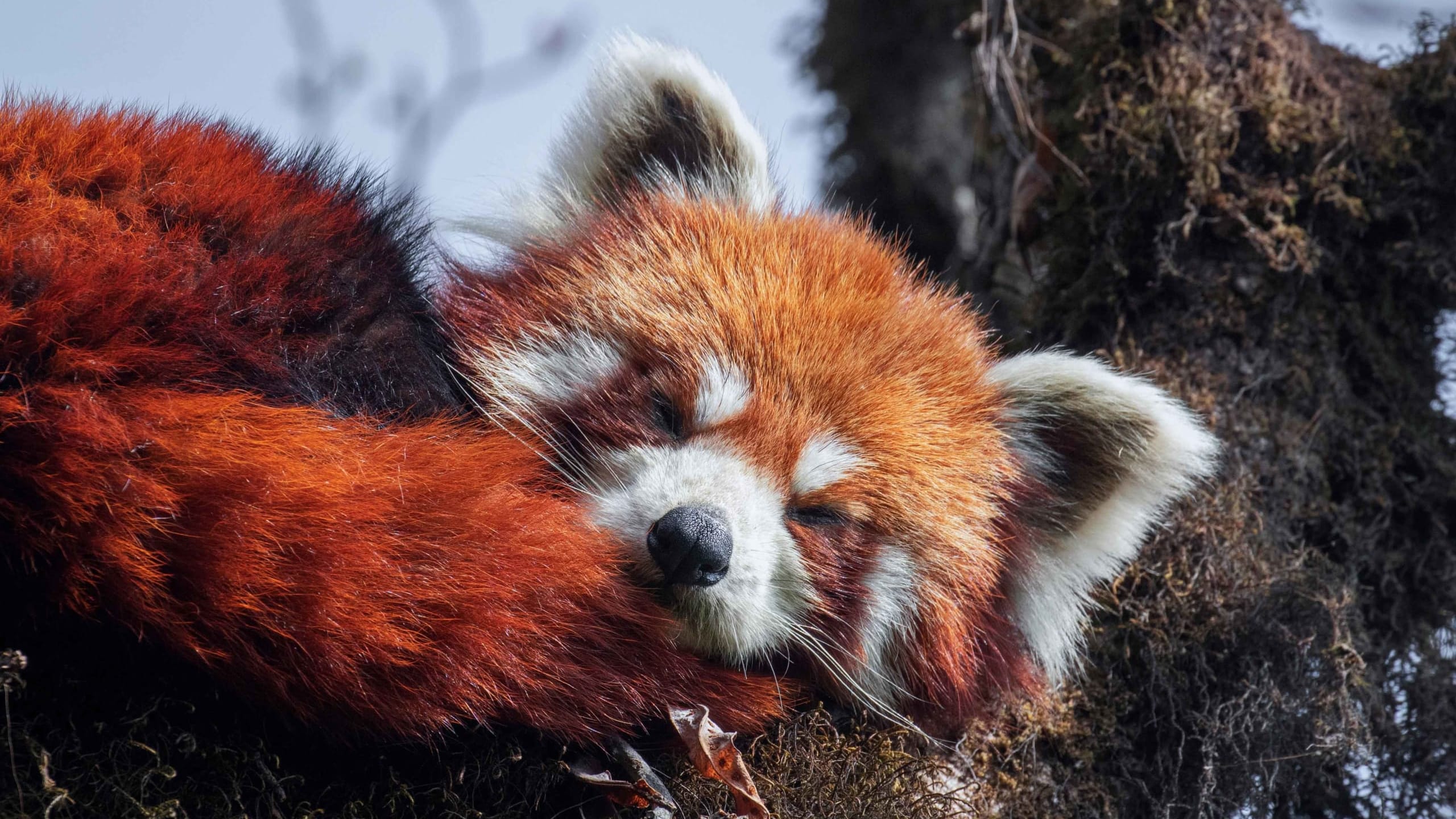 Listen to this article
•
15:34 min
Listen to this article
•
15:34 min
A popular Hindi song blared from a trekker’s portable speaker as he made his way up the cobbled path to Sandakphu, the highest peak in West Bengal. “Ab uska pataa de, zara mujhko bata de, main us se miloonga, ik baar mila de, yaar mila de, dildaar mila de… (Now give me her whereabouts, let me know, I will meet her, just let me meet her once, get me to meet my beloved, get me to meet the one who gave me her heart),” the song went.
“Do you guys know that the endangered red panda is found in these forests,” I overheard him telling his group. Oblivious to him, I was observing his “beloved” from a vantage point off the road, a few metres down the valley.
A young male red panda lounged on the moss-draped branch of a Himalayan oak. The 78.6-sq-km Singalila National Park, renowned for the trek route to Sandakphu that passes through it, is habre (bamboo eater in Nepali) territory. A resident of subtropical, temperate forests and sub-alpine coniferous forests with dense undergrowth of bamboo, the red panda is found in India only in Sikkim, Arunachal Pradesh, and the Darjeeling district of West Bengal.

According to Dr Sunita Pradhan, visiting fellow with the Ashoka Trust for Research in Ecology and the Environment, “Singalila was the first national park in the country to draw attention to the red panda. The study we conducted in 2001 was the first of its kind in India, and we estimated 47 individuals in the park based on our baseline survey”.
In 2012, 27 red pandas were sighted in the park during a census. These arboreal mammals mate only once a year, and the female gives birth to a litter of 1-4 cubs after average gestation period of 131 (average) days, which is unusually long for an animal its size. The cubs take around a year to reach adult size, about 51-66 cm from head to rump, with the tail adding another 25-51 cm. Weighing anywhere between 4.5 to 9 kg, they take another six months to attain sexual maturity. These factors combine to make its recovery from population decline rather slow. “They are very vulnerable, especially the tiny cubs. Humans and wild predators can easily pick them up when they are young,” says Dr Pradhan. Their predators include leopards, martens, and birds of prey.
Unmindful of the onlookers, the bear-cat groomed itself, licking the thick fur on the soles of its feet. Red pandas mark their territories using anal glands, urine and scent glands located between their footpads. Though they subtly vocalise with squeals, twitters, hisses, grunts, whistles and huff-quacks, these quiet animals rely more on scent than sound to communicate with each other. In 2020, scientists confirmed through genetic analysis the existence of two species — the Himalayan red panda (Ailurus fulgens) and the Chinese red panda (Ailurus styani). The Siang River in Arunachal Pradesh separates the two species in India. Dr Pradhan wondered if the revelation would have an impact on captive breeding efforts to conserve the species. “Most of the scientific studies on the red panda are being conducted in China and Nepal. There is still a lot of work to be done in India,” she adds.
Like a human child, the panda in front of me yawned, rubbed its white-cheeked face with its paws, and stretched out to recline on the branch. The brown and maroon, cat-sized animal slowly rested its round head on the branch, wrapped a thick, bushy tail around itself and settled down to snooze. This languid behaviour results from the panda’s slow metabolic rate, an evolutionary strategy to conserve the little energy it gets from a diet low in nutrients.
The panda nonchalantly looked in our direction when Allan, the tracker accompanying me, moved a bamboo stem for a better view. As its white-eyebrowed gaze fixed upon me, I realised that I had locked eyes with a living fossil. The sole living member of the family Ailuridae, this species with no close relatives in the animal kingdom, has changed very little from the time its ancestors roamed across Eurasia tens of millions of years ago. Though the red panda shares its name and habitat with the adored black and white giant panda (Ailuropoda melanoleuca), it is more closely related to skunks and raccoons. However, both pandas have a pseudo-thumb, a modified wrist bone, which they use to grasp bamboo when feeding.
Despite belonging to the order Carnivora, the wild red panda has a largely vegetarian diet comprised of young leaves and shoots of bamboo (their staple diet), fruits, roots, succulent grasses, acorns, lichens, and occasionally, it consumes bird’s eggs, insects, and grubs. “In autumn, the pandas here supplement their diet with wild kiwis and sorbus berries,” Allan adds.
The calm animal became perturbed when another tracker, Sonu, walked along the ridge to see if he could find a better vantage point. Enabled by its extremely flexible ankles, the agile tree dweller climbed headfirst down the trunk. We decided to let the little firefox go on its way and climbed back onto the road.
Shantanu Prasad, naturalist and owner of Habre’s Nest, a research and wildlife tourism centre that employs the trackers, acknowledged that most trekkers are unaware of wildlife in the surrounding forests. “The guides leading these groups aren’t trained properly. If they sensitise trekkers to the red panda’s presence, we will have more people raising their voices to protect this endangered animal. Our motto is to ensure that more people see and fall in love with it. I am certain once you see it, you will want to protect it,” he says.
I peered down through the clumps of bamboo for one last glimpse, but it was gone. Poaching for illegal pet trade, attacks and diseases spread by dogs, and habitat destruction are among the threats red pandas face as they frequently cross the international border between the protected area in India and community forests and unprotected areas in Nepal. “The Indian authorities are helpless when offences take place outside their jurisdiction. The Indian and Nepal governments must work together to create a transboundary red panda conservation reserve here,” Prasad stresses.
A stuffed red panda dangled from the rear-view mirror of our car as we made our way down the mountain, onward to Bagdogra airport. My wandering thoughts circled back to the cherub of the mist as another Hindi love song played on the radio, “Aapke pyaar mai hum savarne lage, dekh ke aapko hum nikharne lage, is kadar aap se humko mohabbat hui, toot ke baazuan mein bikharne lage (I have started to adorn in your love, after seeing you, I’ve started to glow, I am in love with you in such a way that I have started to break into pieces into your arms).”










